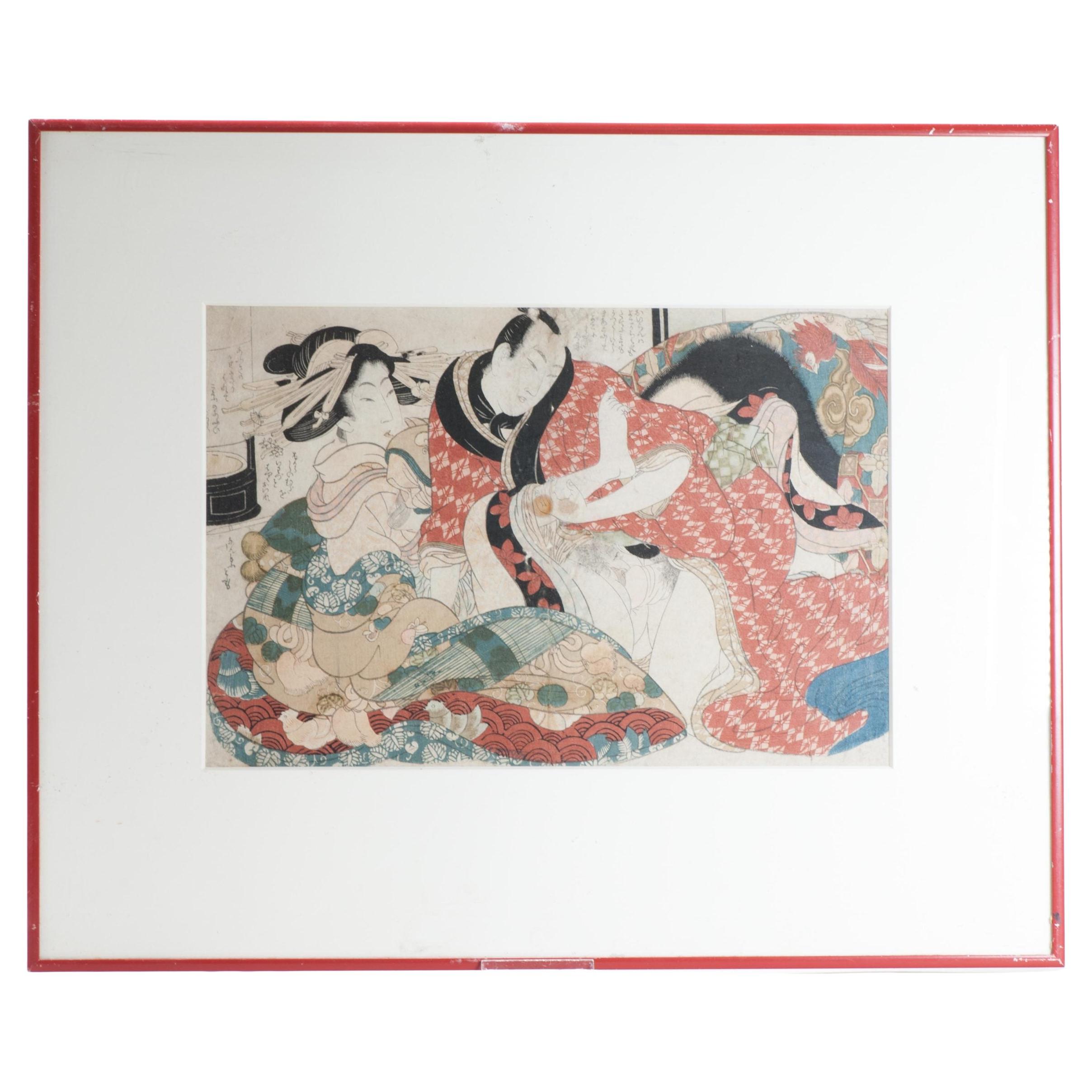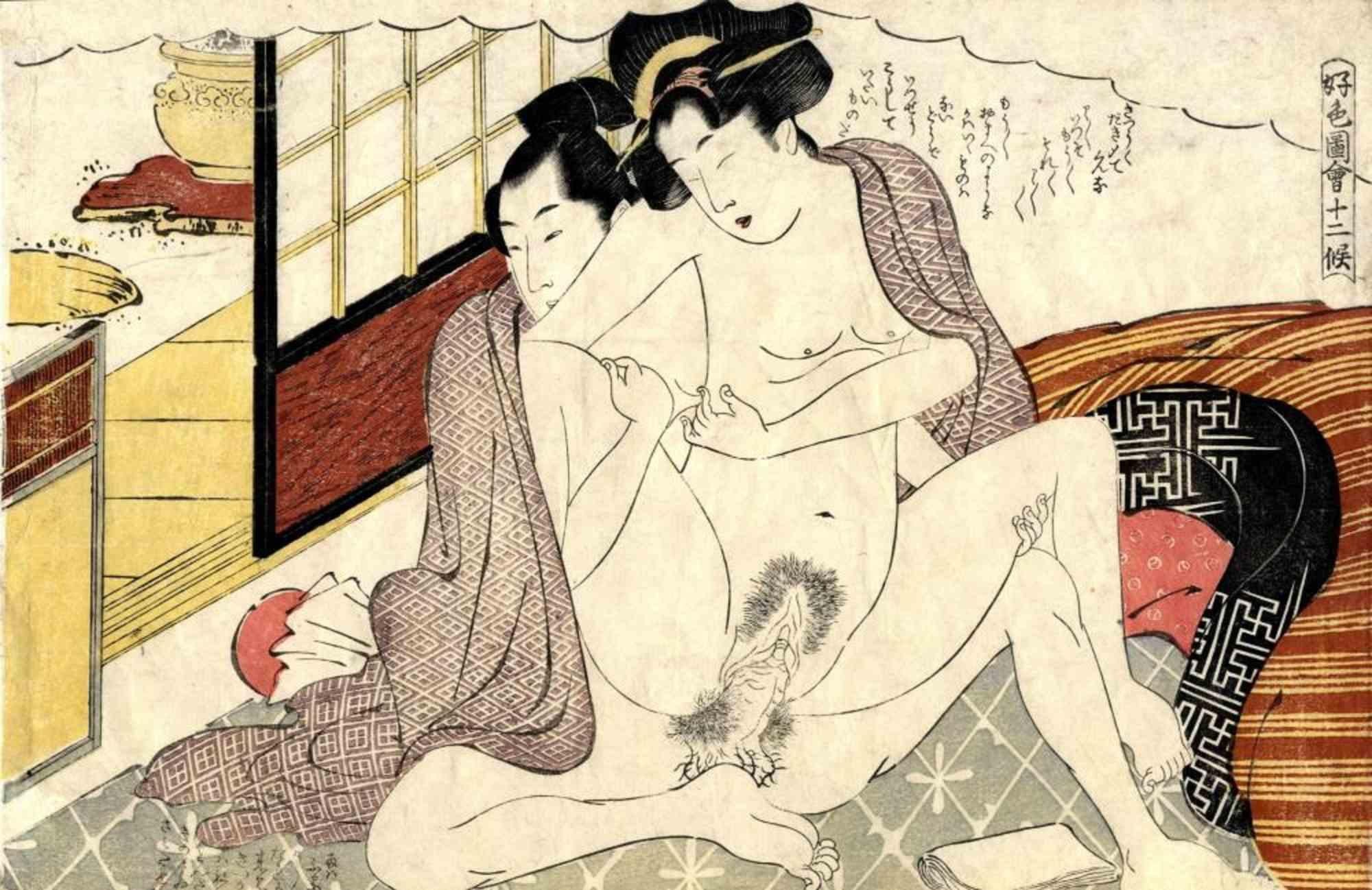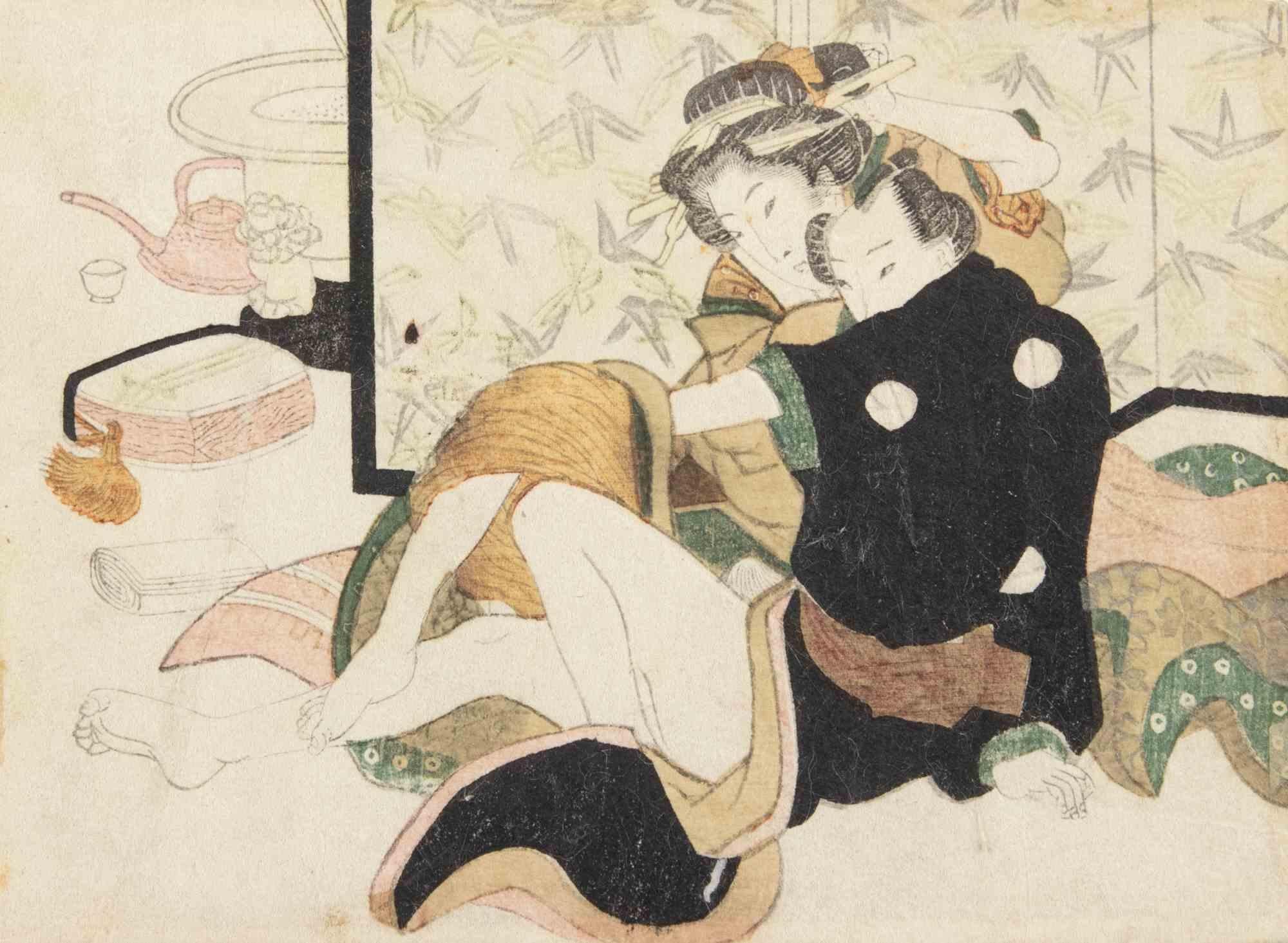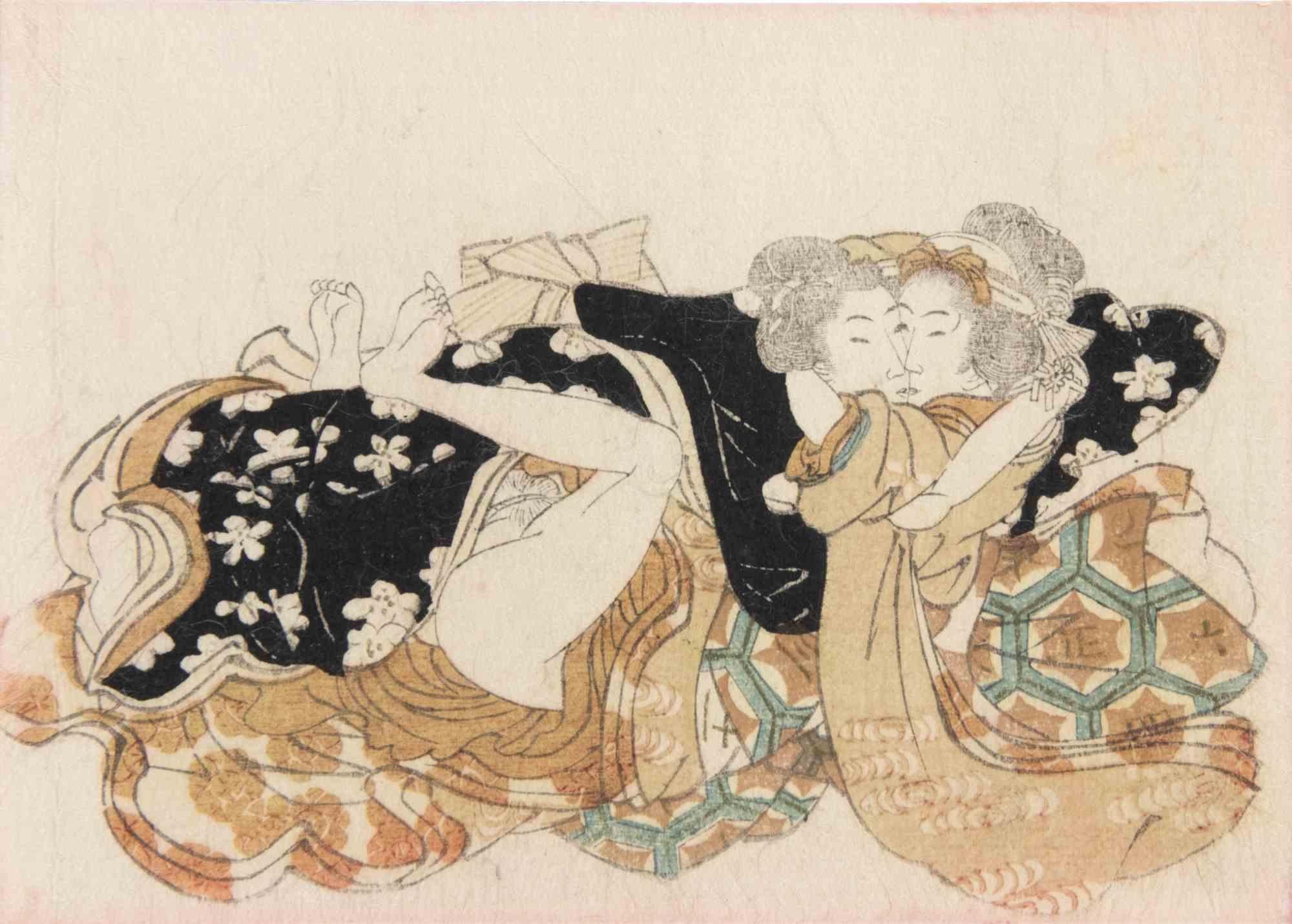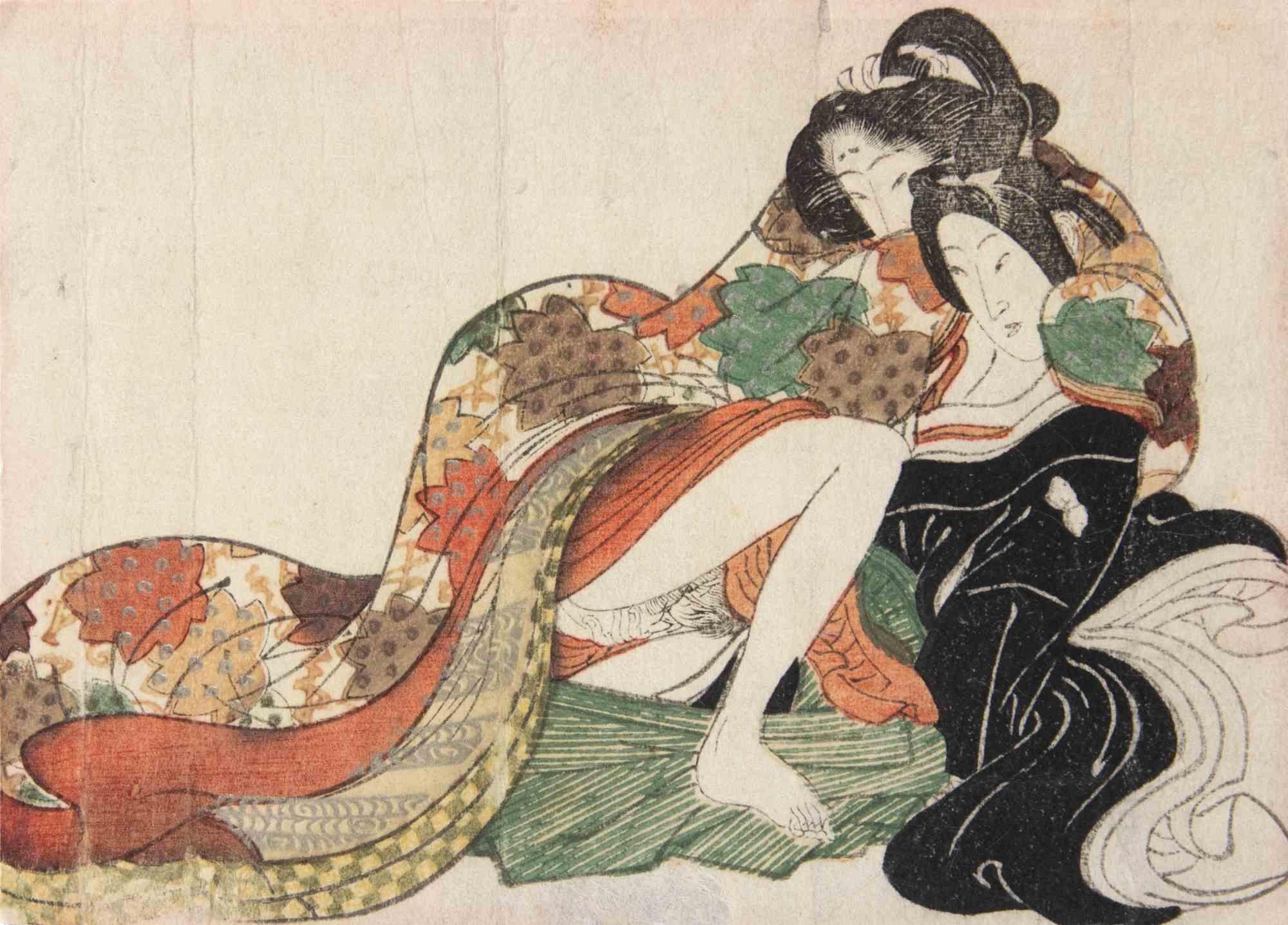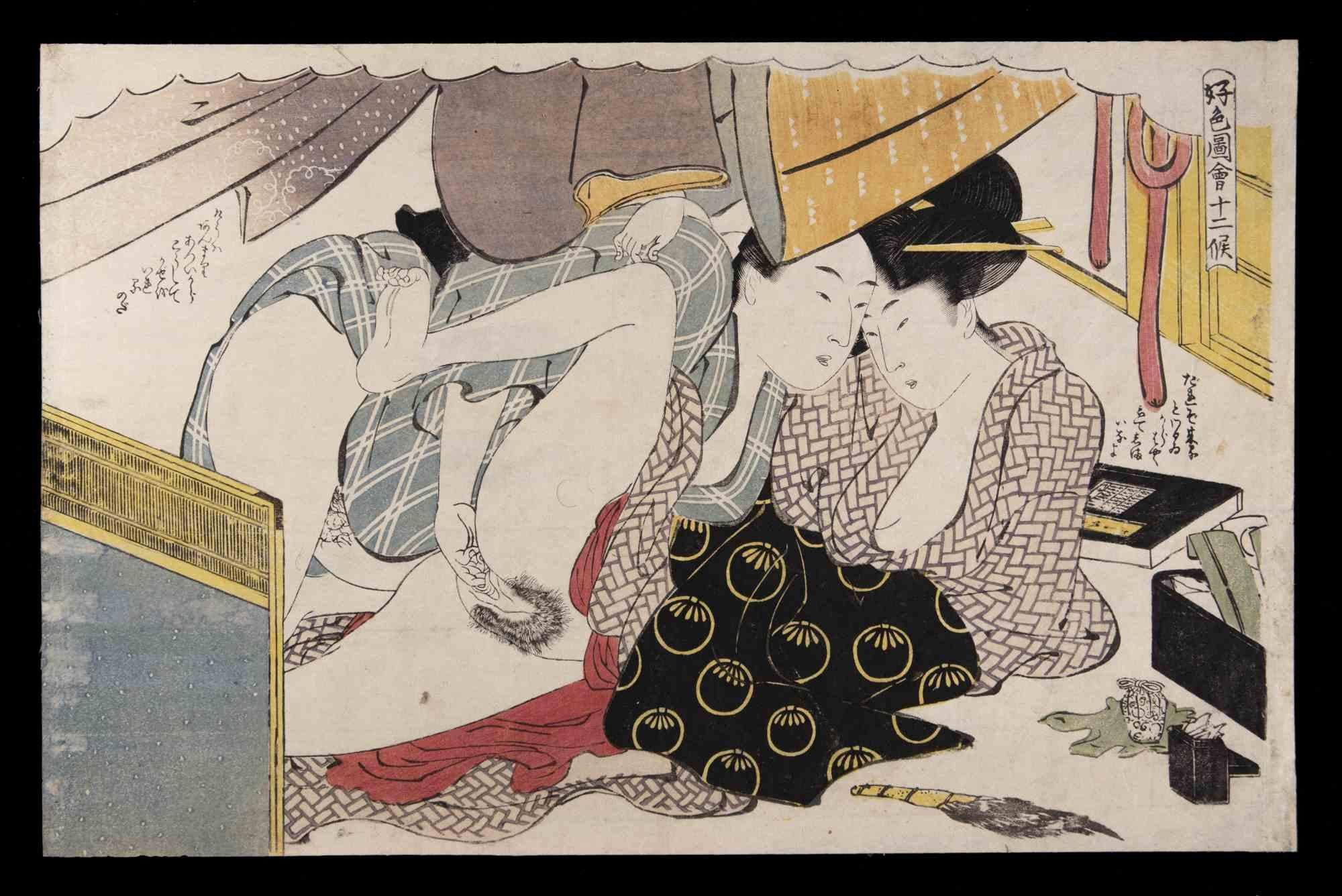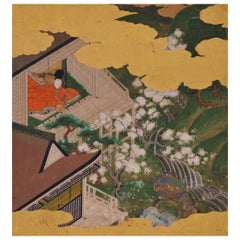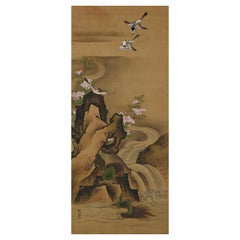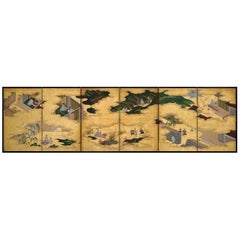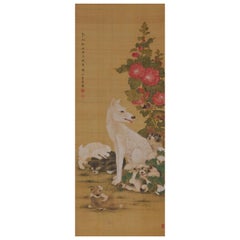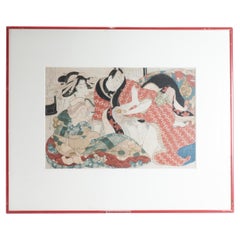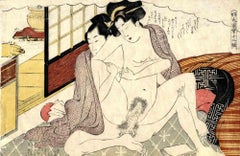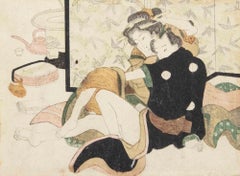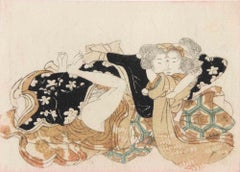Items Similar to 19th Century Japanese Shunga Hand-Scroll, Katsukawa School
Want more images or videos?
Request additional images or videos from the seller
1 of 16
19th Century Japanese Shunga Hand-Scroll, Katsukawa School
$10,750
£8,106.57
€9,375.63
CA$15,082.19
A$16,764.79
CHF 8,787.75
MX$204,738.70
NOK 109,709.93
SEK 103,216.58
DKK 69,977.01
About the Item
Shunga
Unknown artist
Meiji era, circa 1880
Hand-scroll mounted with 12 paintings
Ink, pigment and gofun on silk
Dimensions:
Each image measures H. 23.2 cm x W. 34.4 cm (9.15” x 13.5”)
The hand-scroll measures H. 28 cm x W. 540 cm (11” x 212”)
A set of 12 late 19th century Japanese Shunga paintings mounted as a hand-scroll. Two of the leaves bear the signature and seal ‘Setsuzan’, although we are unable to confirm the identity of the artist using this art name. 6 of the 12 images are taken almost directly from Katsukawa Shuncho’s late 18th century woodblock series, ‘Erotic Pictures for the Twelve Months’. The poses of the protagonists and the lines of their robes are virtually identical. Elements of the backgrounds and the patterns of the kimono have been changed; the text has been removed and replaced with imagery. And this imagery references the original texts and seasons. For example, the eighth painting on this hand-scroll copies a very well known Shuncho woodblock print. There the text tells the story that the couple are enjoying an autumn moon viewing. In the present version the ladies’ undergarment is patterned with rabbits, which is an allusion to the moon and also sexuality. In the 9th painting of the present series, the text has been replaced with a pair of sliding door paintings. The painting shows an idyllic landscape which echoes with themes of solitude and quietude. The text describes a woman who has seduced a young man at the kabuki theatre. She has taken him to an adjacent teahouse during the half-time interval. The young man is worried that they will be heard downstairs, the woman is unconcerned.
In the present painted hand-scroll the colors and pigments are far richer than those used for Shuncho’s original woodblock prints. The scrolls’ vivid palette and lavish materials suggests that this work was made under special order. Such elaborately executed hand-scrolls often found at least nominal justification as accoutrements for a bride’s trousseau. The Katsukawa school of Ukiyo-e artists was particularly popular in the last decades of the 18th century. It’s influence had waned by the mid 19th century. Some 50 artists are known to have been directly connected with and trained by the school. Katsukawa Shuncho, who’s work is the direct inspiration for this set of 12 paintings, drew inspiration for his work from the Ukiyo-e artist Torii Kiyonaga. The painter of this set of paintings, using the name Setsuzan, remains a mystery. He was perhaps a minor artist associated with the very final stages of the Katsukawa school, or more likely an unaffiliated professional painter working on a specific commission during the Meiji period.
The paintings have recently been restored and remounted in Kyoto utilizing traditional techniques and craftsmen. The gold-flecked background paper and the silk front-piece are from the original hand-scroll and have been cleaned and re-used.
- Dimensions:Height: 11 in (27.94 cm)Width: 212 in (538.48 cm)Depth: 0.5 in (1.27 cm)
- Style:Meiji (Of the Period)
- Materials and Techniques:
- Place of Origin:
- Period:
- Date of Manufacture:circa 1880
- Condition:Refinished. The paintings have recently been restored and remounted in Kyoto utilizing traditional techniques and craftsmen. The gold-flecked background paper and the silk front-piece are from the original hand-scroll and have been cleaned and re-used.
- Seller Location:Kyoto, JP
- Reference Number:1stDibs: LU2472328396122
About the Seller
5.0
Recognized Seller
These prestigious sellers are industry leaders and represent the highest echelon for item quality and design.
Established in 2001
1stDibs seller since 2016
71 sales on 1stDibs
Typical response time: 7 hours
- ShippingRetrieving quote...Shipping from: Kyoto, Japan
- Return Policy
Authenticity Guarantee
In the unlikely event there’s an issue with an item’s authenticity, contact us within 1 year for a full refund. DetailsMoney-Back Guarantee
If your item is not as described, is damaged in transit, or does not arrive, contact us within 7 days for a full refund. Details24-Hour Cancellation
You have a 24-hour grace period in which to reconsider your purchase, with no questions asked.Vetted Professional Sellers
Our world-class sellers must adhere to strict standards for service and quality, maintaining the integrity of our listings.Price-Match Guarantee
If you find that a seller listed the same item for a lower price elsewhere, we’ll match it.Trusted Global Delivery
Our best-in-class carrier network provides specialized shipping options worldwide, including custom delivery.More From This Seller
View AllJapanese Painting, 17th Century, Tale of Genji, Tosa School
Located in Kyoto, JP
Illustration to an unidentified chapter of the Tale of Genji (Genji Monogatari)
Tosa School (second half of the 17th Century)
Ink, pigment, gofun and...
Category
Antique Late 17th Century Japanese Edo Paintings and Screens
Materials
Gold Leaf
19th Century Japanese Silk Painting by Kano Chikanobu, Turtles & Azalea
Located in Kyoto, JP
Birds & flowers of the seasons
Pheasants & plum in snow
Unframed painting. Ink, pigment and gofun on silk
Kano Chikanobu 1819-1888
Signature...
Category
Antique Mid-19th Century Asian Edo Paintings and Screens
Materials
Silk
Japanese Screen Painting, Circa 1700 'Tales of Ise' by Tosa Mitsusuke
By Tosa Mitsusuke 1
Located in Kyoto, JP
A six-fold Japanese screen by Tosa Mitsusuke (1675-1710), Japan 17th-18th century, Edo period.
The signature reads Shoroku-i ge Tosa sa Konoe Shogen Mit...
Category
Antique Late 17th Century Japanese Edo Paintings and Screens
Materials
Gold Leaf
1844 - Chichi, Japanese Scroll Painting. Colour on Silk
Located in Kyoto, JP
Mother’s Breast (Chichi) 1844
Hanging scroll. Ink, pigments and gofun on silk.
Inscription:
Kouka era, dragon year, late winter, painted by Shozan Yashou
Artist’ seals:
...
Category
Antique 1840s Japanese Edo Paintings and Screens
Materials
Silk
19th Century Japanese Silk Painting by Kano Chikanobu, Phoenix & Paulownia
Located in Kyoto, JP
Birds & Flowers of the seasons
Pheasants & Plum in Snow
Unframed painting. Ink, pigment and gofun on silk
Kano Chikanobu 1819-1888
Signature...
Category
Antique Mid-19th Century Asian Edo Paintings and Screens
Materials
Silk
19th Century Japanese Scroll Painting, Birds & Flowers of the Four Seasons
Located in Kyoto, JP
Birds and flowers of the four seasons
Early to mid-19th century
Ink, pigment and gofun on silk
Unidentified artist
Signature: S...
Category
Antique 1830s Japanese Edo Paintings and Screens
Materials
Silk
You May Also Like
Antique Edo Period Shunga Woodblock Print by Kikukawa Eizan, 1810-1820
By Kikukawa Eizan
Located in Amsterdam, Noord Holland
Kikukawa Eizan (1787-1867) Dated 1810-1820. The text is about thing happening between lovers. Shunga Print
Nicely framed
Additional information:
Material: Paper
Region of Origin: Ja...
Category
Antique 19th Century Japanese Edo Prints
Materials
Paper
Shunga - Woodcut by Katsukawa Schuncho - Mid-18th Century
By Katsukawa Shunshō
Located in Roma, IT
Shunga is an original modern artwork realized by Katsukawa Schuncho (1726 – 1793) in the half of the 18th Century.
Oban yokoe.
Erotic scene from the series "Koshuko zue juni ko" (Erotic pictures...
Category
1750s Modern Figurative Prints
Materials
Paper, Woodcut
Shunga - Woodcut attr. Keisai Eisen - Mid-19th Century
By Keisai Eisen
Located in Roma, IT
Woodcut shunga print attributed to Keisai Eisen and realized in the early 19th century.
Good condition except for some signs of time.
Category
Mid-19th Century Modern Figurative Prints
Materials
Woodcut
Shunga - Woodcut attr. Keisai Eisen - Mid-19th Century
By Keisai Eisen
Located in Roma, IT
Woodcut shunga print attributed to Keisai Eisen and realized in the early 19th century.
Good condition except for some signs of time.
Category
Mid-19th Century Modern Figurative Prints
Materials
Woodcut
Shunga - Woodcut attr. Keisai Eisen - Mid-19th Century
By Keisai Eisen
Located in Roma, IT
Woodcut shunga print attributed to Keisai Eisen and realized in the early 19th century.
Good condition except for some signs of time.
Category
Mid-19th Century Modern Figurative Prints
Materials
Woodcut
Shunga - Woodcut by Katsukawa Schuncho - Mid-18th Century
By Katsukawa Shunshō
Located in Roma, IT
Shunga is an original modern artwork realized by Katsukawa Schuncho (1726 – 1793) in the half of the 18th Century.
Erotic scene from the series "Koshuko zue juni ko".
A courtesan with a customer under a kimono stand...
Category
Mid-18th Century Modern Portrait Prints
Materials
Paper, Woodcut
More Ways To Browse
Antique Scroll
Ink Scroll
Japanese Hand Scroll
19th Century Japanese Scroll
Traditional Japanese Painting
19th Century Theatre
Antique School Doors
Japanese Paper Scroll
Meiji Scroll
Pair Of Japanese Paintings
Japanese Scrolls Painting
19th Century Ink Wells
Used Screen Doors
Silk Japanese Scrolls
Antique Japanese Scroll Painting
Japanese Silk Painting Ink
18th Century Hand Screen
Japanese Sliding Doors
